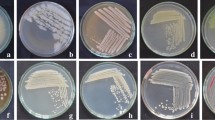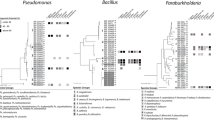Certain antagonistic bacteria are considered ideal biological control agents owing to their rapid growth, easy handling and aggressive colonization of the rhizosphere. These bacteria may mediate biocontrol by one or more of the several mechanisms of disease suppression (Weller 1988). A primary mechanism of pathogen inhibition is by the production of secondary metabolites and other factors such as siderophore production and microbial cyanide, and lytic enzymes may also play a role (Fravel 1988; Keel et al. 1992; O’Sullivan and O’Gara 1992). These bacteria are involved in the biological control of bacterial, fungal, and viral diseases of plants.
Access this chapter
Tax calculation will be finalised at checkout
Purchases are for personal use only
Preview
Unable to display preview. Download preview PDF.
Similar content being viewed by others
References
Bangera GM, Thomashow LS (1996) Characterization of a genomic locus required for synthesis of the antibiotic 2,4-diacetylphloroglucinol by the biological control agent Pseudomonas fluorescens Q2–87. Mol Plant Microbe Interact 9:3155–3163
Bangera GM, Thomashow LS (1999) Identification and characterization of a gene cluster for synthesis of the polyketide antibiotic 2,4-diacetylphloroglucinol from Pseudomonas fluorescens Q2–87. J Bacteriol 181:3155–3163
Barry GF (1988) A broad-host-range shuttle system for gene insertion into the chromosomes of Gram-negative bacteria. Gene 71:75–84
Chatterjee A, Valasubramanian R, Ma WL, Vacchani AK Gnanamanickam SS, Chatterjee AK (1996) Isolation of mutants of Pseudomonas fluorescens strain Pf7–14 altered in antibiotic production, cloning of ant+ DNA and evaluation of antibiotic production in the control of blast and sheath blight of rice. Biol Control 7:185–195
Defago G, Berling CH, Burger U, Haas D, Kahr G, Keel C, Voisard C, Wirthner P, Wuthrich B (1990) Suppression of black root rot of tobacco and other diseases by strains of Pseudomonas fluorescens: potential applications and other mechanisms. In: Hornby D, Cook RJ, Henis Y, Ko WH, Rovira AD, Schippers B, Scott BR (eds) Biological control of soilborne plant pathogen. CAB International, Wallingford, pp 93–108
Dowling DN, O’Gara F (1994) Metabolites of Pseudomonas involved in the biocontrol of plant disease. Trends Biotechnol 12:133–141
Fravel DC (1988) Role of antibiotics in the biocontrol of plant diseases. Annu Rev Phytopathol 26:75–91
Garagulya AD, Kiprianova EA, Boiko IO (1974) Antibiotic effect of bacteria from the genus Pseudomonas on phytopathogenic fungi. Mikrobiol Zh 36:197–202
Gutterson N (1990) Microbial fungicides: recent approaches to elucidating mechanisms. Crit Rev Biotechnol 10:69–91
Gutterson NL, Layton TJ, Warren GJ (1986) Molecular cloning of genetic determinants for inhibition of fungal growth by a fluorescent pseudomonad. J Bacteriol 165:696–703
Gutterson N, Ziegle JS, Warren GJ, Layton TJ (1988) Genetic determinants for catabolic induction of antibiotic biosynthesis in Pseudomonas fluorescens HV37a. J Bacteriol 170:380–385
Hossain M (1996) Recent developments in the Asian rice economy: challenge for the rice research. In: Evenson RE, Herdt, RW, Hossain M (eds) Rice research in Asia: progress and priorities. CAB International, Wallingford, pp 11–17
Howell CR, Stipanovic RD (1979) Control of Rhizoctonia solani on cotton seedlings with Pseudomonas fluorescens and with an antibiotic produced by the bacterium. Pytopathology 69:480–482
Howie WJ, Suslow TV (1991) Role of antibiotic biosynthesis in the inhibition of Pythium ultimum in the cotton spermosphere and rhizosphere by Pseudomonas fluorescens. Mol Plant Microb Interact 4:393–399
Ishiyama S (1922) Studies on the white leaf disease of rice plants. Rep Agric Exp Stn Tokyo 47:233–251
James DJ, Gutterson NI (1986) Multiple antibiotics produced by Pseudomonas fluorescens HV37a and their differential regulation by glucose. Appl Environ Microbiol 52:1183–1189
Kavitha S (2002) Strategies for management of rice blast and sheath blight with bacterial biocontrol agents in combination with major genes for disease resistance. PhD thesis, University of Madras, Chennai
Keel C, Schinder U, Maurhofer M, Voisard C, Laviller J, Burger U, Wirthner P, Haas D, Defago G (1992) Suppression of root diseases by Pseudomonas fluorescens CHAO: Importance of the bacterial secondary metabolite 2,4-diacetylphloroglucinol. Mol Plant Microbe Interact 5:4–13
Keel C, Weller DM, Natsch A, Defago G, Cook RJ, Thomashow LS (1996) Conservation of the 2,4-diacetylphloroglucinol biosynthesis locus among fluorescent Pseudomonas strains from diverse geographic locations. Appl Environ Microbiol 62:552–563
Krishnamurthy K (1997) Biological control of rice blast and sheath blight by Pseudomonas spp.: survival and migration of the biocontrol agents and the induction of systemic resistance in biological disease suppression. PhD thesis, University of Madras, Chennai
Levy E, Gough FJ, Berlin KD, Guiana PW, Smith TJ (1992) Inhibition of Septoria tritici and other phytopathogenic fungi and bacteria by Pseudomonas fluorescens and its antibiotics. Plant Pathol 41:335–341
Mew TW (1987) Current status and future prospects of research on bacterial blight of rice. Annu Rev Phytopathology 25:59–382
Mew TW, Alvarez AM, Leach JE, Swings J (1993) Focus on bacterial blight of rice. Plant Dis 77:5–11
Morrison DA (1979) Transformation and preservation of competent bacterial cells by freezing. Methods Enzymol 68:326–331
Narayanan NN, Baisakh N, Vera Cruz CM, Gnanamanickam SS, Datta K, Datta SK (2002) Molecular breeding for the development of blast and bacterial blight resistance in rice cv. IR50. Crop Sci 50:2072–2079
Narayanan NN (2001) Molecular breeding for the development of transgenic rice resistant to blast and bacterial blight diseases. PhD thesis, University of Madras, Chennai
Nowak-Thompson B, Gould SJ, Kraus J, Loper JE (1994) Production of 2,4-diacetylphloroglucinol by the biocontrol agent Pseudomonas fluorescens Pf-5. Can J Microbiol 40:1064–1066
O’Sullivan DJ, O’Gara F (1992) Traits of fluorescent Pseudomonas spp. involved in the suppression of plant root pathogens. Microbiol Rev 56:662–676
Ou SH (1985) Rice diseases, 2nd edn. Commonwealth Mycological Institute, Kew
Raaijmakers JM, Weller DM, Thomashow LS (1997) Frequency of antibiotics-producing Pseudomonas spp. in natural environments. Appl Environ Microbiol 63:881–887
Reddy TKK, Borovkov AV (1970) Antibiotic properties of 2,4-diacetylphloroglucinol produced by strain Pseudomonas fluorescens strain 26–0. Antibiotiki 15:19–21
Srivastava DN (1967) Epidemiology and control of bacterial blight of rice in India. Proceedings of a symposium on rice diseases and their control by growing resistant varieties and other measures, Japan. Agric For Fis Res Counc Agric For Tokyo Jpn 11–18
Swings J, Van den Mooter M, Vauterin L, Hoste B, Gillis M, Mew TW, Kersters K (1990) Reclassification of the causal agents of bacterial blight (Xanthomonas campestris pv. oryzae) and bacterial leaf streak (Xanthomonas campestris pv. oryzicola) of rice as pathovars of Xanthomonas oryzae (ex Ishiyama 1922). sp. nov., nom. rev. Int J Sys Bacteriol 40:309–331
Tagami Y, Mizukami T (1962) Historical review of the researches on bacterial blight of rice caused by Xanthomonas oryzae (Uyede and Ishiyama) Dowson. Spec Rep Plant Dis Insect Pests Forecast Serv 10:112
Tagami Y, Kuhara S, Kurita T, Fujii H, Sekiya N, Yoshimura S, Sato T, Watanabe B (1963) Epidemiological studies on the bacterial leaf blight of rice, Xanthomonas oryzae (Uyeda et Ishiyama) Dowson. I. The overwintering of the pathogen. Bull Kyushu Agric Exp Stn Japan 9:89–122
Thara KV (1994) Biological control of rice sheath blight by bacterial antagonists: mechanisms of disease suppression. PhD thesis, University of Madras, Chennai
Thomashow LS, Weller DM (1988) Role of phenazine antibiotic from Pseudomonas fluorescens in biological control of Gaeumannomyces graminis var. tritici. J Bacteriol 170:3499–3508
Thomashow LS, Weller DM (1995) Current concepts in the use of introduced bacteria for biological disease control: mechanisms and antifungal metabolitesm. In: Stacey G, Keen N (eds) Plant-microbe interactions, vol 1. Chapman and Hall, New York, pp 187–235
Valasubramanian R (1994) Biological control of rice blast with Pseudomonas fluorescens Migula: role of antifungal antibiotics in disease suppression. PhD thesis, University of Madras, Chennai
Vasudevan P (2002) Isolation and characterization Bacillus spp. from the rice rhizosphere and their role in biological control of bacterial blight of rice caused by Xanthomonas oryzae pv. oryzae. Ph.D thesis, University of Madras, Chennai
Vasudevan P, Kavitha S, Priyadarisini VB, Babujee L, Gnanamanickam SS (2002) Biological control of rice diseases. In: Gnanamanickam SS (ed) Biological control of crop diseases. Decker, New York, pp 11–32
Velusamy P (2003) Biological control of bacterial blight of rice by plant-associated bacteria: Molecular and genetic analyses of metabolites for their role in disease control. PhD thesis, University of Madras, Chennai
Velusamy P, Gnanamanickam SS (2003) Plant-associated bacteria, 2,4-diacetylphloroglucinol (DAPG) production and suppression of rice bacterial blight in India. Curr Sci 85:1270–1273
Velusamy P, Immanuel E, Gnanamanickam SS, Thomashow L (2006) Biological control of rice bacterial blight by plant-associated bacteria producing 2,4-diacetylphloroglucinol. Can J Microbiol 52:56–65
Wakimoto S (1956) Hibernation of leaf blight disease bacteria in soil. Agric Hortic Jpn 31:413–1414
Weller DM (1988) Biological control of soilborne plant pathogens in the rhizosphere with bacteria. Annu Rev Phytopathol 26:379–407
Weller DM, Cook RJ (1983) Suppression of take-all of wheat by seed treatments with fluorescent pseudomonads. Phytopathology 73:463–469
Yoshimura S, Tahara SK (1960) Morphology of bacterial leaf blight organism under (electron) microscope. Ann Phytopathol Soc Jpn 26:61
Author information
Authors and Affiliations
Editor information
Editors and Affiliations
Rights and permissions
Copyright information
© 2008 Springer-Verlag Berlin Heidelberg
About this chapter
Cite this chapter
Velusamy, P., Gnanamanickam, S.S. (2008). The Effect of Bacterial Secondary Metabolites on Bacterial and Fungal Pathogens of Rice. In: Karlovsky, P. (eds) Secondary Metabolites in Soil Ecology. Soil Biology, vol 14. Springer, Berlin, Heidelberg. https://doi.org/10.1007/978-3-540-74543-3_5
Download citation
DOI: https://doi.org/10.1007/978-3-540-74543-3_5
Publisher Name: Springer, Berlin, Heidelberg
Print ISBN: 978-3-540-74542-6
Online ISBN: 978-3-540-74543-3
eBook Packages: Biomedical and Life SciencesBiomedical and Life Sciences (R0)




